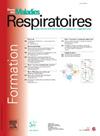Rhinovirus and severe asthma: Decoding epithelial dysfunction and inflammatory responses
IF 0.5
4区 医学
Q4 RESPIRATORY SYSTEM
引用次数: 0
Abstract
Introduction
Alteration of bronchial epithelium is one of the main features of severe asthma. Bronchial epithelial cells promote and perpetuate airway inflammation and structural changes leading to persistent symptoms, bronchial obstruction and hyperresponsiveness. Bronchial epithelial cells are the first barriers in viral infections, which are the major contributor to asthma exacerbations. However, the consequences of the persisting long-term responses to viral infection of bronchial epithelium in severe asthma are not fully understood. Therefore, we investigated the in vitro response to rhinovirus of epithelial cells obtained from control donors or severe asthma patients and performed a long-term follow-up.
Methods
Primary human bronchial epithelial cells (HBECs) from control (C) (n = 6) and severe asthmatics (SA) (n = 6), cultured in air-liquid interface (ALI), were infected with Rhinovirus A16 (RV-A16). Differences in term of viral replication, epithelium cohesion (TEER measurement), antiviral and inflammatory responses (protein secretion) were assessed at the acute phase and at the late phase. Moreover, a single-cell RNA-sequencing analysis was performed at 3-, 7- and 14-days post-infection.
Results
RV-A16 replication increased during the acute phase then decreased during the late phase, without any significative difference between C and SA. Epithelium cohesion was damaged by RV-A16 in SA at the late phase whereas it was strengthened in C. RV-A16 induced the secretion of various antiviral defence peptides (IFN type I and III) and inflammatory mediators (CXCL10, IL 33, TSLP) over the first week post-infection, with different kinetics and intensities between C and SA. For example, IL-33, TSLP, IFNλ2-3 and IFNα2 secretions were significantly more induced in SA than in C. By contrast, MUC5AC secretion was significantly less important in SA than in C. Single-cell RNA sequencing data revealed that SA epithelia displayed fewer genes up-regulated after RV-A16 infection than C epithelia for all cell types (max 202 genes upregulated in multiciliated cells vs max 1262 genes upregulated in goblet cells respectively at 3 dpi). NF-kB pathway (e.g: RIPK1, TNFAIP3, NFKBIA, MYD88) was enriched only in C at 3 dpi, not in SA.
Conclusion
The antiviral response is different between control and severe asthmatic, both in the acute and late phases. The virus induces alteration of epithelium cohesion in severe asthmatics, suggesting a defect in cellular events normally induced by injury. Then, an altered response of HBECs in severe asthma, illustrated by the increased secretion of epithelial alarmins and the deficiency of NF-kB pathway, could contribute to increased disease susceptibility and an enhanced persistent inflammatory response to rhinovirus infection.
鼻病毒和严重哮喘:解码上皮功能障碍和炎症反应
支气管上皮的改变是严重哮喘的主要特征之一。支气管上皮细胞促进和延续气道炎症和结构改变,导致持续症状、支气管阻塞和高反应性。支气管上皮细胞是病毒感染的第一道屏障,而病毒感染是哮喘恶化的主要原因。然而,严重哮喘患者对支气管上皮病毒感染持续长期反应的后果尚不完全清楚。因此,我们研究了来自对照供体或严重哮喘患者的上皮细胞对鼻病毒的体外反应,并进行了长期随访。方法采用空气液界面(ALI)培养的人支气管上皮细胞(HBECs)感染鼻病毒A16 (RV-A16)的方法,分别对对照组(C) (n = 6)和重症哮喘患者(SA) (n = 6)进行检测。在急性期和晚期评估病毒复制、上皮内聚(TEER测量)、抗病毒和炎症反应(蛋白质分泌)方面的差异。此外,在感染后3、7和14天进行单细胞rna测序分析。结果hbv - a16复制在急性期增加,在晚期减少,C和SA之间无显著差异。在感染后的第一周内,RV-A16诱导多种抗病毒防御肽(IFN I型和III型)和炎症介质(CXCL10、IL 33、TSLP)的分泌,在C和SA之间具有不同的动力学和强度。例如,IL-33、TSLP、ifn - λ2-3和IFNα2的分泌在SA中明显高于C,而MUC5AC的分泌在SA中明显低于C。单细胞RNA测序数据显示,在所有细胞类型中,RV-A16感染后SA上皮中表达上调的基因都少于C上皮(在多毛细胞中最多202个基因上调,而在杯状细胞中最多1262个基因上调)。NF-kB通路(如RIPK1、TNFAIP3、NFKBIA、MYD88)在3 dpi时仅在C中富集,而在SA中不富集。结论对照组和重症哮喘患者的抗病毒反应在急性期和晚期均有差异。病毒诱导严重哮喘患者的上皮内聚改变,提示通常由损伤引起的细胞事件存在缺陷。因此,HBECs在严重哮喘中的反应改变,表现为上皮警报器分泌增加和NF-kB通路缺乏,可能导致疾病易感性增加和对鼻病毒感染的持续炎症反应增强。
本文章由计算机程序翻译,如有差异,请以英文原文为准。
求助全文
约1分钟内获得全文
求助全文
来源期刊

Revue des maladies respiratoires
医学-呼吸系统
CiteScore
1.10
自引率
16.70%
发文量
168
审稿时长
4-8 weeks
期刊介绍:
La Revue des Maladies Respiratoires est l''organe officiel d''expression scientifique de la Société de Pneumologie de Langue Française (SPLF). Il s''agit d''un média professionnel francophone, à vocation internationale et accessible ici.
La Revue des Maladies Respiratoires est un outil de formation professionnelle post-universitaire pour l''ensemble de la communauté pneumologique francophone. Elle publie sur son site différentes variétés d''articles scientifiques concernant la Pneumologie :
- Editoriaux,
- Articles originaux,
- Revues générales,
- Articles de synthèses,
- Recommandations d''experts et textes de consensus,
- Séries thématiques,
- Cas cliniques,
- Articles « images et diagnostics »,
- Fiches techniques,
- Lettres à la rédaction.
 求助内容:
求助内容: 应助结果提醒方式:
应助结果提醒方式:


